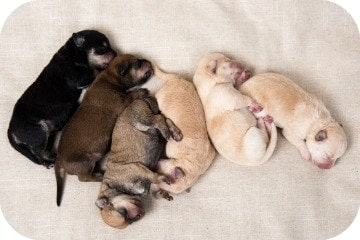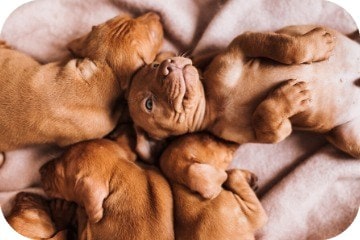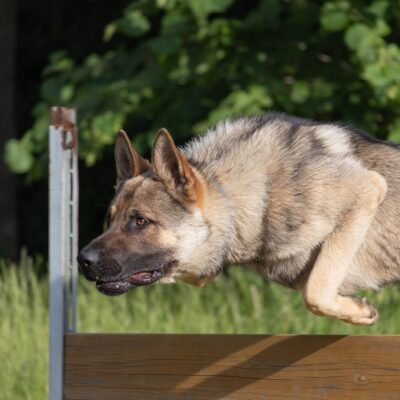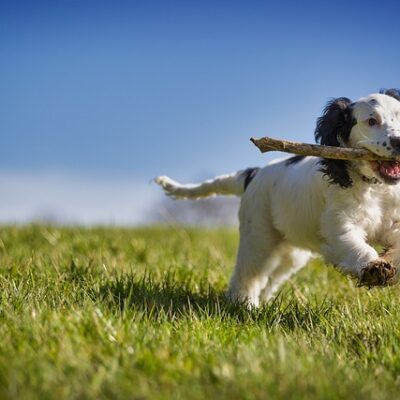
WHAT IS THE RUNT OF THE LITTER?
The runt is the smallest or weakest in a litter of animals. The term ‘runt’ is not a recognized medical term, more of a common term.
Which one is the runt? In dogs, it is the weakest and smallest puppy, which is underweight for its breed. It is usually easy to tell which is the runt of the litter, if there is one, as the size difference is significant.
Being the smallest or weakest gives them the most significant chance of health issues. However, this is not always the way.
Busy? Get Your Hands Paws On The Answers Quickly…
- Commonly Asked Questions About The Runt
- Runt Puppy Development and Caring For A Runt
- Should You Pick The Runt?
COMMONLY ASKED QUESTIONS ABOUT THE RUNT

Is there always a runt?
No, not all litters have runts. Factors which may heighten the chances of a runt are:
- Medium to large breeds of dog – Bigger breeds tend to have bigger litters. Therefore the dams nutrients and care are more thinly spread across more puppies.
- Health – Any dog which is not in premium health, or is too young or too old is more likely to produce a less desirable, weaker litter.
Is the runt born last?
Usually, but not always. Many times people think the dam is finished birthing and then the runt will appear. However, this is not always the case. The position in which they are born does not determine whether or not they are a runt.
Why is the runt so small?
It is not known for sure; there are many theories, many of which are disproven or not scientifically accurate. These are the most common:
- Fewer nutrients in the uterus – The uterus is Y shaped, people suspect that the runt has the disadvantaged position of being in the middle, the furthest away from the blood supply and therefore the nutrients. Meaning they don’t get ‘fed’ as well when growing. Many people oppose this theory as the puppies move around when growing.
- Conceived later – Others think the puppies could have been conceived at different times, with the runt being last. This would mean that the puppy is premature and, therefore, weaker and smaller. This could be a possibility that they were sired by different fathers or at different times, but the chances are incredibly low.
- Congenital disabilities – Birth defects can affect the physical, mental, and developmental stages of a puppy’s growth. This could lead to them being smaller than the rest.
The runt is usually born considerably tinier and weaker than the rest of the littermates. Size can play a big part when the puppies have to fight their way to nurse. The runt can end up feeding less and, therefore, not get enough nutrients to catch up with their littermates. It can become a reoccurring cycle, with the runt consistently not gaining weight.
Can there be more than one runt?
Yes, any puppy which is underweight at birth could be considered a runt. So a litter could have no runts, two runts, or the whole litter.
However, most litters have one very distinct runt who is considerably smaller and weaker than the rest.
Is the runt a boy or a girl?
A runt could be either male or female, and the runt is not decided by sex, but by weight and size.
Why does the mother reject the runt?
Runts are not always rejected; there are many cases of the mother taking more time to care for them away from the other puppies.
In the wild many runts are rejected by their mothers and left to fend for themselves. Sadly this usually ends one way.
The runt is at a disadvantage to its littermates; they struggle more to fight for nutrients and warmth. The mother may reject this puppy if they think they are too weak to survive. They will give their attention and nutrients to the other puppies. Naturally it is survival of the fittest.
If you are raising puppies, a dam should be observed with the runt. Things to check:
- Are they suckling? Check when the runt is latched onto the mother that they are feeding. The puppy can be moved closer to the tail where there are the most nutrients. This position will also keep them warmer.
- Are they warm and close to the mother and other pups? Puppies need to be kept warm and rely on their mother for warmth. They are not able to regulate their temperature for several weeks.
If you feel the runt is being rejected, not getting enough food, and unable to keep themselves close and, therefore, warm, you may need to step in.
RUNT PUPPY DEVELOPMENT AND CARING FOR A RUNT
If the mother has rejected the runt or you are fearful that they are not gaining weight as well as the others, you may need to begin hand-rearing the runt.
Weigh The Puppies: A puppy who is considered underweight is 25% or more under the average weight. Weigh the puppies daily to keep an eye on them and ensure they are feeding. The vet will be able to advise the safe weight gain for your breed.
Feeding: If the runt has been rejected or is not gaining weight fast enough, they will need special food. Colostrum is essential in the first 48 hours of birth. It is a fluid produced by the mother to help the puppy’s immunity and health long-term.
Do not feed the run baby formula or cows milk as it is not rich enough in nutrients for a puppy. Take the puppy to the vet, and they will be able to provide supplementary food.
Warmth: Keep the puppy warm, heating pads or lights can be purchased. Newborn puppies need to be kept at 85 -90°F (29.5-32°C), with the temperature, slowly decreasing with age.
Toileting: Puppies cannot toilet alone; the mother would stimulate them to eliminate themselves by licking. You may need to rub the area to promote them to go.
SHOULD YOU PICK THE RUNT?

The tiniest puppy often catches the heart of many prospective puppy parents who want to care and give extra nourishment to the weakest. However, are there any reasons we shouldn’t be picking the runt?
Our opinion is that if you are purchasing from a repeatable breeder who is open and honest, the puppy seems well socialized, is not lethargic compared to the others, has normal stools, and is within the healthy weight for the breed at time of purchase, there should be no reason not to choose the runt.
However, if you are looking to breed, work, or show your dog, keep in mind the breed standards. If the dog is not of the premium quality, they may not do so well in these areas, and regardless, they can make great pets.
These are our additional considerations on choosing the runt:
Health
The dam and sire should both be health checked before buying a puppy, and a reputable breeder will be able to provide this information. Not that this necessarily provides an accurate insight into how the runt will be. However, it can give you a good indication of any health problems the puppies could face in the future.
Puppies who don’t get the adequate colostrum from their mother in the first 48 hours can be prone to infections and parasites. However, if the runt manages to be weaned at the right time and survives the first 4-6 weeks of life, it is likely to grow into a healthy dog.
It has not been proven that runts are any more prone to long term health ailments than their littermates.
When you buy a puppy, always make sure to have them health checked within the first few days to highlight any congenital or heart issues.
Behavioral Issues
Frequently people assume that the runt will be shyer, timid, and more passive than the other littermates. While this could be the case, that puppy has had to fight for survival. This could be displayed in food guarding and scavaging in later life. However, this is not proven to be a direct correlation.
Development Issues
Runts may be harder to train, including potty training. This could be due to their reduced size, or it has been suggested that they are mentally less mature.
Bonding With Humans
Hand-reared puppies are often found to form closer, more loving bonds with humans as opposed to other dogs. Most tamed wild animals are hand-reared.
However, if a runt was not reared well and spent its entire time being bullied by the mother and other pups, they may be more independent and less able to form close bonds.
Price and Size
Irresponsible breeders may underprice or overprice the runt. Puppies in one litter should all cost the same.
Overprice: Breeders may take advantage of a tiny runt. They may tell you they are a small, designer ‘teacup’ puppy. This is entirely inaccurate and incredibly irresponsible.
If you are looking for a smaller dog buy a smaller breed, the runt tends to grow just as big as their littermates with proper care. Or, in fiction, even bigger, take Clifford, the big red dog. He was a runt who didn’t stop growing.
Underprice: If the breeder is charging different amounts for different puppies, go to another breeder. Often they know something you don’t, and you’ll end up paying for it in vet bills later on.
Given the knowledge, understanding, vet services, food development, socialization classes, and puppy training courses we have access to, the majority of runts will thrive in the 21st century.
Get in touch – if you’ve ever owned or raised a runt, let us know your experience below!
Looking for more pawsome posts? Check these out…
Can Dogs Eat Lettuce?
How To Make A Snuffle Mat
When Do Puppies Lose Their Teeth?
Can Dogs Eat Broccoli?
Can Dogs Eat Watermelon?
Disclaimer: Each dog is different, and every circumstance is different. All efforts have been made to provide accurate information. However, it is not provided by a qualified Veterinarian, Veterinarian Surgeon, or Behaviorist. The information provided is purely educational. The information should not be used as an alternative or substitute for medical care. If you have any health or medical concerns, contact a qualified Veterinary Surgeon or Veterinarian immediately.










No Comment! Be the first one.